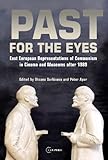Past for the Eyes : East European Representations of Communism in Cinema and Museums After 1989 / ed. by Oksana Sarkisova, Péter Apor.
Material type: TextPublisher: Budapest ; New York : Central European University Press, [2022]Copyright date: ©2008Description: 1 online resource (436 p.)Content type:
TextPublisher: Budapest ; New York : Central European University Press, [2022]Copyright date: ©2008Description: 1 online resource (436 p.)Content type: - 9786155211430
- 791.430947 22
- PN1993.5.E82 P37 2008
- online - DeGruyter
| Item type | Current library | Call number | URL | Status | Notes | Barcode | |
|---|---|---|---|---|---|---|---|
 eBook
eBook
|
Biblioteca "Angelicum" Pont. Univ. S.Tommaso d'Aquino Nuvola online | online - DeGruyter (Browse shelf(Opens below)) | Online access | Not for loan (Accesso limitato) | Accesso per gli utenti autorizzati / Access for authorized users | (dgr)9786155211430 |
Frontmatter -- Contents -- Introduction -- Documents Of Communism: Lost And Found -- Documents Of Communism: Lost And Found -- The Man in the White Raincoat -- Communist Secret Services on the Screen. The Duna-gate Scandal in and beyond the Hungarian Media -- Façades The Private and the Public in Kádár’s Kiss by Péter Forgács -- The Experiences of a Filmmaker. Reconstructing Reality from Documents in Communist Archives -- Subjects of Nostalgia: Selling the Past -- Out of the Past. Memories and Nostalgia in (Post-)Yugoslav Cinema -- Long Farewells. The Anatomy of the Soviet Past in Contemporary Russian Cinema -- The Economics of Nostalgia. Socialist Films and Capitalist Commodities in Contemporary Poland -- “We Have Democracy, Don’t We?” Czech Society as Reflected in Contemporary Czech Cinema -- Objects of Memory: Museums, Monuments, Memorials -- The Redistribution of the Memory of Socialism. Identity Formations of the “Survivors” in Hungary after 1989 -- Raising the Cross. Exorcising Romania’s Communist Past in Museums, Memorials and Monuments -- The “Unmemorable” and the “Unforgettable.” “Museumizing” the Socialist Past in Post-1989 Bulgaria -- Containing Fascism. History in Post-Communist Baltic Occupation and Genocide Museums -- How Is Communism Displayed? Exhibitions and Museums of Communism in Poland -- About the Authors -- Name Index -- Subject Index
restricted access online access with authorization star
http://purl.org/coar/access_right/c_16ec
How do museums and cinema shape the image of the Communist past in today’s Central and Eastern Europe? This volume is the first systematic analysis of how visual techniques are used to understand and put into context the former regimes. After history “ended” in the Eastern Bloc in 1989, museums and other memorials mushroomed all over the region. These efforts tried both to explain the meaning of this lost history, as well as to shape public opinion on their society’s shared post-war heritage. Museums and films made political use of recollections of the recent past, and employed selected museum, memorial, and media tools and tactics to make its political intent historically credible. Thirteen essays from scholars around the region take a fresh look at the subject as they address the strategies of fashioning popular perceptions of the recent past.
Mode of access: Internet via World Wide Web.
In English.
Description based on online resource; title from PDF title page (publisher's Web site, viewed 29. Jul 2022)


